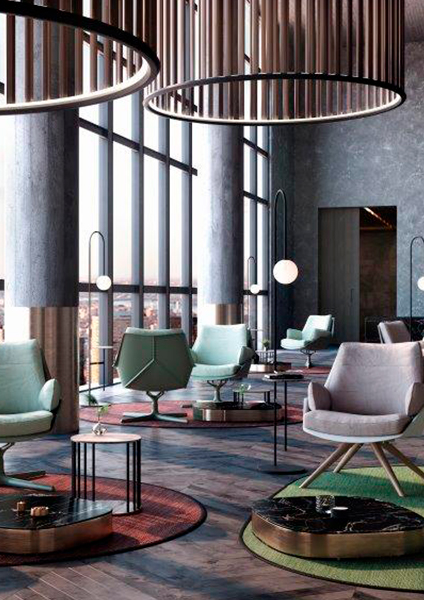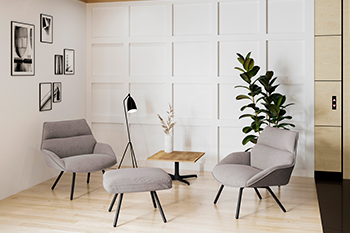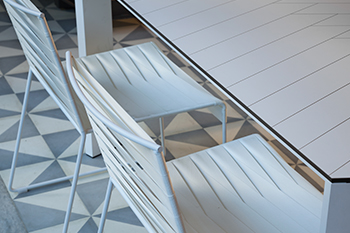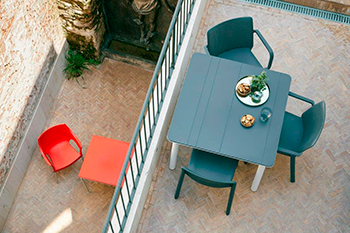Blog
Ergonomic design in communal areas is of utmost importance in various sectors, including hotels, hospitality, restaurants, offices and, in short, any space that requires contract furniture. In these environments, an ergonomic approach not only contributes to users' comfort but also has a significant impact on operational efficiency and customer satisfaction.
What is ergonomics in communal areas?

Ergonomics is a fundamental discipline that seeks to adapt environments to people, taking their needs and comfort into account. In essence, the idea is to create spaces that adjust to the people using it in a natural, healthy way.
In the hotel and hospitality sector, ergonomically-designed communal areas such as halls and reception areas not only create a positive first impression but also facilitate the flow of guests and staff. Ergonomic furniture like well-designed chairs and tables, allows visitors to relax and socialise in comfort. This in turn improves the customer's experience.
With this in mind, Resol offers a wide range of possibilities. The armchairs from the Anou collection are the ideal solution for halls and reception areas. They are characterised by their ergonomic design and unbeatable comfort. Available in versions like the Toledo and the Rocking, they give the impression of sitting in a cloud. Now, with the Fully Upholstered Anou version, the experience is further enhanced, offering a higher level of luxury and sophistication. These armchairs are the perfect choice for those looking for furniture that combines comfort and style for their spaces.
In office environments, the ergonomic design of communal areas like break rooms and meeting rooms can improve employees' productivity and well-being. Ergonomic chairs and sofas promote correct posture and reduce the risk of ergonomic health problems like back pain and carpal tunnel syndrome.
A clear example of ergonomic design is our Espiga Chair, designed by Jordi Ribaudí. Its ergonomic focus sets it apart. Its painted steel base structure makes it stable and hard-wearing. The fireproof and waterproof polyester used for the seat and back not only guarantees safety but is also very comfortable for the user. Additionally, its non-slip pads and stainless steel screws contribute to the chair's stability and strength, ensuring a high quality ergonomic experience. This chair combines functionality and design to offer a comfortable, safe chair for a range of environments.
The Noa table, designed by David Carrasco, joins the Espiga chair in the search for ideal ergonomics. With its tabletop and legs made of injected polypropylene, this table is not only durable and hard-wearing but also takes the user's comfort into account. The fibreglass-reinforced legs guarantee optimum stability and its UV protection makes it suitable for both indoor and outdoor use, allowing it to adapt to various scenarios. When combined with the Espiga chair, the Noa Table creates a complete ergonomic environment that combines functionality and design to offer a comfortable, versatile experience in a wide range of spaces.
In infrastructures such as conference rooms, auditoriums and convention centres, ergonomics is essential to accommodate large groups of people comfortably and efficiently. The provision of ergonomic chairs and tables can have an impact on participation and the success of events.
Goals of ergonomic design
As we have already mentioned, the main goal of ergonomics is to improve peoples' quality of life. This is achieved through various key aspects:
- Comfort: Ergonomics aims for people to feel comfortable in their environment. This means designing furniture and layouts that avoid forced or uncomfortable postures, thus reducing fatigue and physical stress.
- Health: Ergonomic designs contribute to people's health by preventing musculoskeletal problems and other ailments related to posture and repetitive movements.
- Efficiency: Ergonomic spaces promote efficiency and productivity. Adjusting work environments or shared spaces to people's needs reduces time-wasting and increases concentration.
- Safety: Ergonomics also focuses on users' safety. An ergonomic design reduces the risk of accidents and injury as it removes obstacles and provides the logical, safe distribution of elements.
Ergonomic solutions for communal areas
Ergonomic solutions play a fundamental role in the optimisation of communal areas, which are areas for social interaction and intense activity. At Resol, we specialise in improving people's experience through design, prioritising their health and well-being. By adapting to human needs, we create environments that are more pleasant and functional and safer for everyone. Ergonomics has become an essential ally for architects, designers and town planners in the search for a more comfortable, healthier world.
If you are looking for ergonomic solutions for your communal areas, please don't hesitate to contact our team. We offer tailored solutions for each project, including adapted furniture and advice on all key aspects of ergonomics such as the smart design, lighting, acoustics and accessibility of spaces. We are here to help you create environments that prioritise the well-being and comfort of those who use them.


